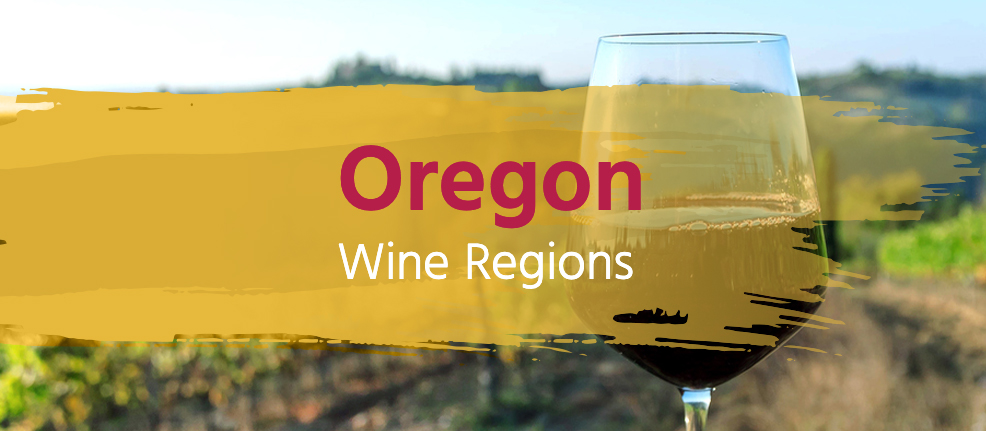
The founders of Oregon’s wine industry were onto something. The rich, volcanic soil, the mountain-cloaked hills, the moderate temperatures and long growing season make this Pacific Northwest state a winemaker’s Eden. The sustainability of the region’s natural growing conditions doesn’t hurt, either.
Amid all this, Oregonian wine often goes underappreciated — and even neglected. We’re here to change that, celebrating the best wine regions of Oregon’s vibrant, eclectic wine repertoire.
Table of Contents
- Applegate Valley
- Chehalem Mountains
- Columbia Gorge
- Columbia Valley
- Dundee Hills
- Eola-Amity Hills
- McMinnville
- The Rocks District of Milton Freewater
- Rogue Valley
- Snake River Valley
- Umpqua Valley
- Yamhill-Carlton
- Explore the Best of Oregon’s Wines
Oregon State Wine Regions: Map Overview
Oregon contains 19 official wine-growing regions, or appellations. Tucked within these 19 appellations are over 750 wineries producing 72 distinct grape varietals annually.
As a whole, Oregon’s cooler climate brings temperate days and crisp nights, letting grapes mature longer on the vines and retaining their signature acidity. However, there are crucial distinctions across its 19 major appellations. From rainfall amounts and soil composition to topography, each Oregonian winery’s outputs reflect of these unique conditions. The result is an array of flavor profiles, palates, bodies and textures.
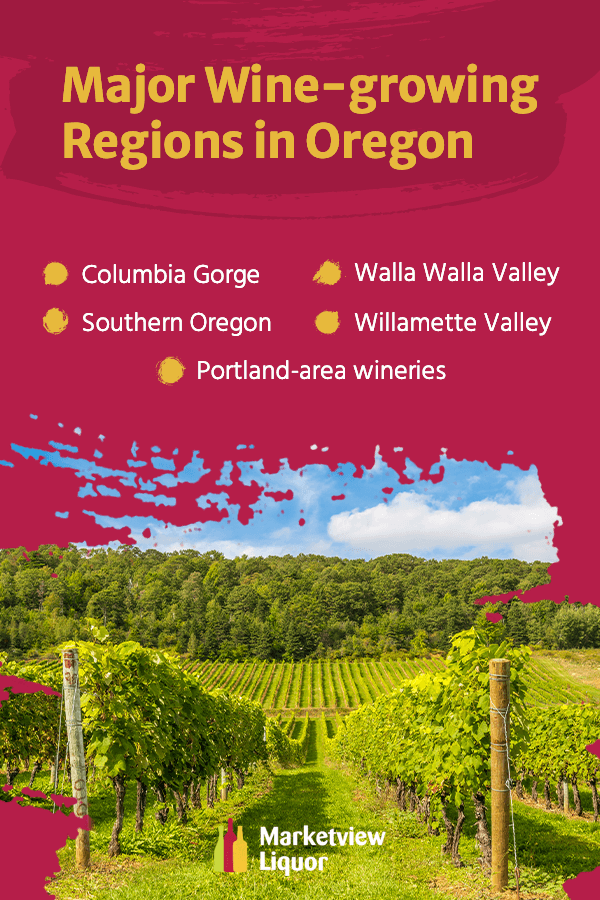
Explore these top five major wine-growing regions in Oregon to begin discovering all the state has to offer.
- Columbia Gorge: The 40-mile Columbia Gorge AVA straddles the Oregon-Washington border and boasts being “America’s most unique wine region.” It certainly is a distinct one. With vines tracing the cold Columbia River and shadowed between Mt. Adams and Mt. Hood, Columbia Gorge produces expressively fruity, light and bright varietals due to its alpine-like terroir.
- Portland-area wineries: Portland is a trendsetter for many reasons, including its urban winery scene. The city contains 15 official wineries sourcing varietals from across the state, yet blending and bottling within the City of Roses. Its burgeoning wine scene comes on the heels of the city’s wider foodie renaissance, making Portland a premier destination for hungry, curious tourists to wine connoisseurs seeking niche favorites.
- Southern Oregon: Oregon’s Southern AVA threads the mighty Cascade Mountains, starting at the base of Eugene and reaching down to Oregon’s southwest corner. It is the state’s warmest AVA, with more arid growing conditions compared to the rest of Oregon. The Southern Oregon AVA is also distinct for its highly sedimentary soil and vineyard positionings along high points of its rolling mountainside valleys, allowing vines to capture and retain ripening moisture.
- Walla Walla Valley: Fun to say and even more fun to explore, Walla Walla Valley’s wines come from a 2,000-acre spread of loess and basalt bedrock sitting in the shadows of the Palouse and Blue Mountains. Wines here balance vibrant berry notes with tart, tongue-tickling acidity, coaxed during the region’s warm summers followed by heavy annual rainfalls.
- Willamette Valley: The largest of Oregon’s wine AVAs, Willamette Valley is home the highest concentration of wineries in the entire state. It sits perfectly positioned for cool-climate grape outputs, producing some of Oregon’s best pinot noirs. This grape varietal, in particular, benefits greatly from Willamette Valley’s coastal marine characteristics, mild-temperature wet winters, sunny, gentle summers and naturally well-draining soil.
Best Oregon Wine Regions
Wines from Oregon are finally receiving the praise they deserve. Lush, bright and often balancing berry fruit notes with fresh bursts of acidity, the state’s top varietals include pinot noirs, pinot gris and merlot — though why stop there?
Explore some of Oregon’s major wine subregions producing some of the highest-quality red and white wines in the U.S.
1. Applegate Valley
Tucked neatly in a 50-mile spread between the California border and Rogue River’s Grant’s Pass, Applegate Valley represents Oregon’s wine history itself.
Not only is it where Oregon’s very first official winery, Valley View, opened in 1873. Applegate Valley also cultivates one of the most extensive range of grape varietals in its home state, including warm-weather varietals like Syrah and Rhone-style red blends difficult to master in Oregon’s cooler northern AVAs.
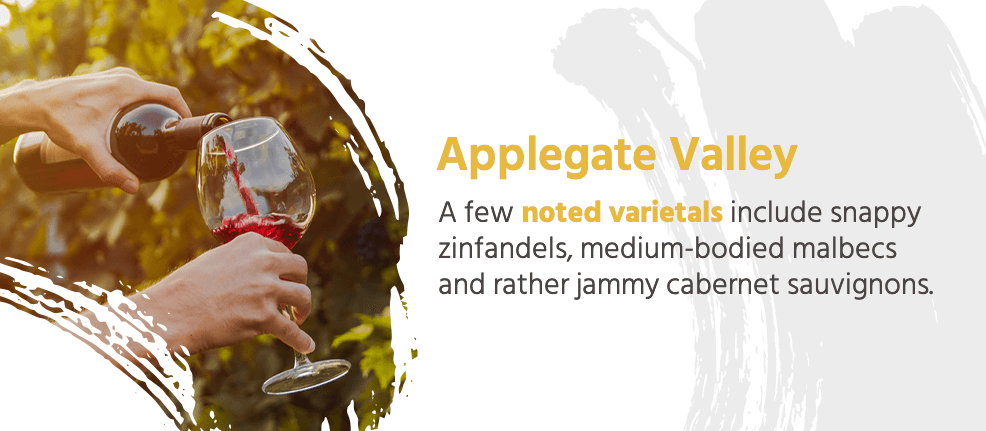
Other noted Applegate Valley varietals include snappy zinfandels, medium-bodied malbecs and rather jammy cabernet sauvignons. Many of these grapes grow on vines perched on higher elevations, sometimes nearly 2,000 feet above sea level, hugged by the region’s notably dryer air. Many Applegate Valley vineyards harness natural topological elements like alluvial fans or the region’s stream terraces to help trap and flush moisture, creating a granite-based loamy soil perfect for vine drainage.
Today’s Applegate Valley wineries carry on the legacy of grape diversity and distinction. Many are family-run, and you can visit most of them on an official or self-paced tour along Applegate Wine Trail.
2. Chehalem Mountains
The Chehalem Mountains, located in the expansive Willamette Valley AVA, rose to fame in the late 1970s after a blossoming of noted wine pioneers purchased plots near its namesake mountain range. They quickly took to embracing the region’s highly variable temperatures and winter rainfalls. Weather conditions are so variable throughout the Chehalems that some vineyards only a few miles apart will experience weeks-long differences in the ripening of their grapes, leading to significant tasting and olfactory differences.
Pinot noir reigns supreme in the Chehalem Mountain subregion. That’s because pinot noir grapes, perhaps more than any other wine varietal, ripen quickly when exposed to too much heat. Aggravated ripening leads to immature, sharp and flat wines worsened by a pinot noir’s preference for soft, supple soil. Together, these conditions cut pinot noir from the list of many other region’s favored plantings — but make it perfect for Chehalem.
Travel along its 20-mile-long, only five-mile-wide border, and you’ll encounter some of the New World’s finest pinot noir varieties. You’ll pick up fragrant and delicate variations in oak aging and fermentation techniques harmonized by the varietal’s medium tannins and elegant, silky finish.
3. Columbia Gorge
Roughly an hour’s drive outside Portland sits the Columbia Gorge, one of Oregon’s oldest and finest subregions.
Don’t let its size fool you. While Columbia Gorge’s regional border is barely 40 miles in total, its winemakers cultivate an incredible number of high-quality varietals from its mountainous terrain, developing some prolific cool-climate varietals starting to turn heads in the wine world.
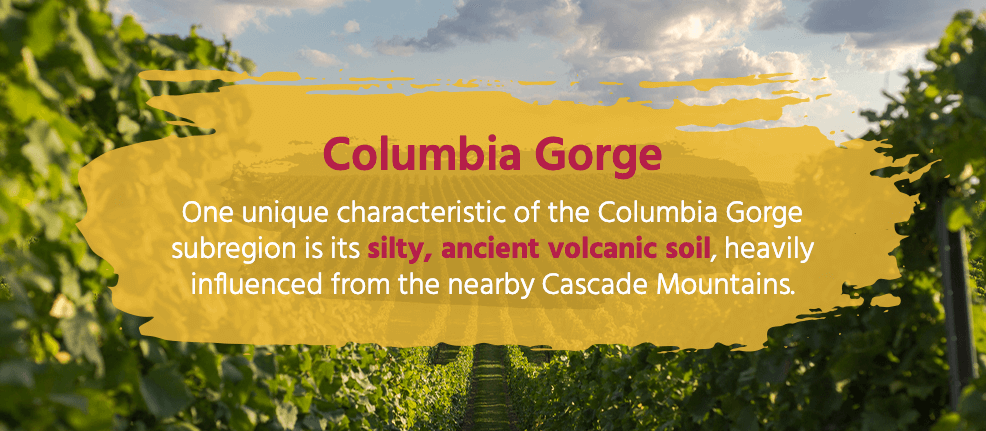
One unique characteristic of the Columbia Gorge subregion is its silty, ancient volcanic soil, heavily influenced from the nearby Cascade Mountains. To keep things interesting, try wines from wineries in both Columbia Gorge’s eastern and western plots. This longitudinal terroir difference is one of the most striking and influential aspect of Columbia Gorge producers. Those in the east experience high desert climates, blocked from the Pacific weather and moisture influences of their western cousins. With barely 10 inches of annual rainfall, east Columbia Gorge wines will include varietals from Syrah and chardonnay to Sangiovese, while the cooler west welcomes vines like pinot gris and riesling.
American history buffs may take a particular liking to Columbia Gorge, as well. As the only westward sea-level passage through the Cascade Mountain Range, Columbia Gorge saw the likes of the Lewis and Clark expedition traverse through its canyon on their way to the Pacific.
4. Columbia Valley
With over 11 million acres to its name, Columbia Valley is an expansive Oregon state wine region with plenty to offer new and seasoned wine lovers alike.
Come for the wine, stay for the breathtaking landscapes. Natural landmarks define most of the appellation’s borders, including steady mountain slopes to the west and north and the Columbia River itself claiming the south. The valley is also home to a lace-like tapestry of tributaries weaving through the valley floor, each serving as a backdrop near many vineyard benchlands.
Naturally well-draining yet dry, sandy soil makes up Columbia Valley’s terroir. The northern region averages at most 10 inches of rainfall a year, though six to eight is far more common. Many Columbia Valley wine producers plant their vines along southern-facing slopes, aiming to capitalize on the subregion’s continental desert climate. This positioning lets grapes reap the rewards of long, slow, warm ripening during the day and reliable cool-down periods at night, preserving their precious acidity.
Popular varietals grown in Oregon’s Columbia Valley include cabernet sauvignon, merlot and grenache, as well as Rhone and Bordeaux-style red blends. Red zinfandel is also relatively common and was the first varietal introduced to the area over 100 years ago.
5. Dundee Hills
A hop and a skip away from Portland — and only 40 miles from the Pacific Ocean — Dundee Hills blends cool-climate growing conditions with high-slope positioning to produce some of Oregon’s most acclaimed bottles.
Part of the subregion’s success is its rich, mineral-dense red volcanic Jory soil indigenous to the area. Vineyards here enjoy the nutrients awarded from clay, silt and loam components and superior drainage. This Jory soil also runs relatively deep, in some places extending up to six feet beneath the surface before revealing denser soil types.
We can thank the region’s volcanic activity as well as active tectonic plates for its prime grape-growing conditions. Most Dundee Hill growers plant their vineyards along north-south ridges, called spines, sitting around 1,000 feet above sea level. This elevation is much higher than neighboring subregions plant theirs, yet furthers the soil’s natural drainage and provides the perfect spot to plant fickle pinot noir grapes. Dundee Hills also receives a fair amount of rainfall. Winemakers can expect between 30 to 50 inches annually, mostly outside of the growing season, though.
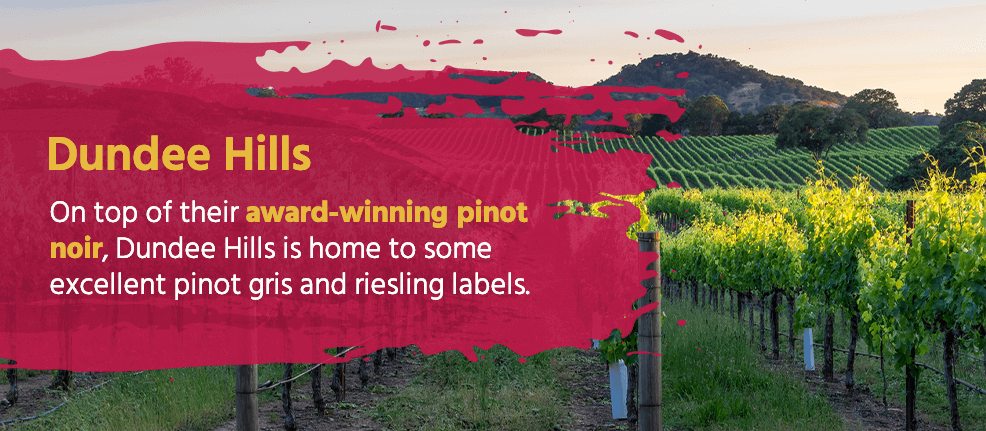
On top of their award-winning pinot noir, Dundee Hills is home to some excellent pinot gris and riesling labels. For off-the-beaten-path drinkers, Dundee Hill-produced sparkling and dessert wines can be exceptionally complex and delicious, making the perfect end to a meal with friends.
6. Eola-Amity Hills
Another subregion of the Willamette Valley, Eola-Amity, is a distinct area sitting right near Oregon’s capital of Salem.
Cool coastal air leaks through Van Duzer Corridor just west of Eola-Amity. The crisp, saline winds help maintain more moderate temperatures even during the hottest summer months. It is also a significant reason Eola-Amity Hills wineries produce the lush, high-acidity wines they do, watered by over 40 inches of rain a year. We’re not complaining.
Pinot noir, pinot gris and chardonnay dominate the landscape here. Each of these varietals benefits from Eola-Amity Hills’ cool climates and volcanic-basalt soil, enriched by ancient lava residue and sediment. Wineries at lower sea level ridges may find their soil slightly on the rockier side. The combination of shallow rocks with deeper, volcanic-infused compounds is the perfect combination for higher-bodied, more concentrated wines. Again, we’re not complaining.
Given the region’s size, Eola-Amity Hills releases tend to go fast — especially the small-release experimental varietals that come from a few of its staple vineyards. With over 100 registered vineyards within its AVA borders, it also isn’t difficult to find a producer. The region has earned a reputation for its commitment to sustainability and biodynamic practices, with many of its vineyards committed to this type of winemaking.
7. McMinnville
Stumble into the northwest corner of Willamette Valley, and you may find yourself in McMinnville.
The subregion is named after its nearest town and encompasses what it means to be in the Willamette region — but with a few twists. Vineyards here tend to sit higher than their valley neighbors, sometimes up to 1,000 feet above sea level. The higher elevations prevent frost from reaching the grapes, as well as produce slightly drier moisture levels and higher temperatures during the growing season.
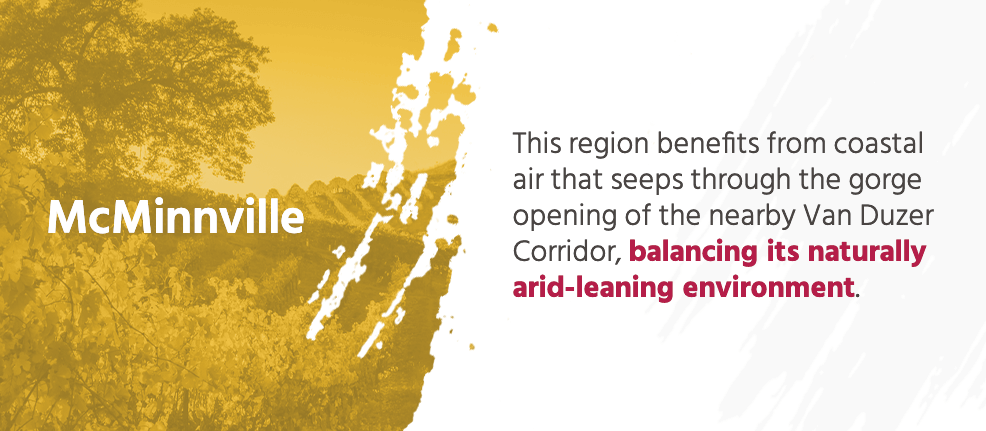
McMinnville still benefits from coastal air that seeps through the gorge opening of the nearby Van Duzer Corridor, balancing its naturally arid-leaning environment. The result is a complex, well-balanced range of varietals expressing sweet and acidic notes, rounded by firm bodies and lingering finishes.
Wine lovers worldwide may know McMinnville for another reason. Every year, the namesake town hosts the International Pinot Noir Celebration. With a name like that, we bet you can guess its focus: three days dedicated to everything and anything pinot noir, including tastings, tours, farm-to-table food pairings, educational seminars, special events and much more. The celebration draws in hundreds of attendees and vendors annually, animating the local economy and making McMinnville a must-do pilgrimage for pinot noir lovers.
8. The Rocks District of Milton Freewater
The Rocks District of Milton Freewater, barely totaling six square miles, is the second-smallest subregion in all of Oregon. The tiny district produces high-quality wines on par with far larger regions due to its unique terroir, earning its AVA designation in 2017.
Syrahs rule the roost around the Rocks District. Most notably, syrahs from Milton-Freewater vineyards carry rich, heavy and even perfumed aromas punctuated by a unique flavor palate. Tasters experience that quintessential cool-climate fruitiness balanced by bold florals like violets and lavender. The Rocks District takes things even further, elevating fresh black pepper, licorice and truffle flavors against a strong, acidic backbone.
Most Rocks District Syrah producers try to avoid introducing oak flavors into the fold. Though syrahs age well, the heaviness of oak barreling can often clash with the acidic and aromatic signatures of their region’s claim to fame.
The Rocks District gets its name from its distinct soil as well. Rockier and drier than many other areas in the state, the Rocks District of Milton-Freewater best supports hearty, deep-rooted grape varietals. Some are so robust that you can still find patches of wild vines sprinkled across the oldest vineyards in Walla Walla Valley — some dating back to the Gold Rush.
9. Rogue Valley
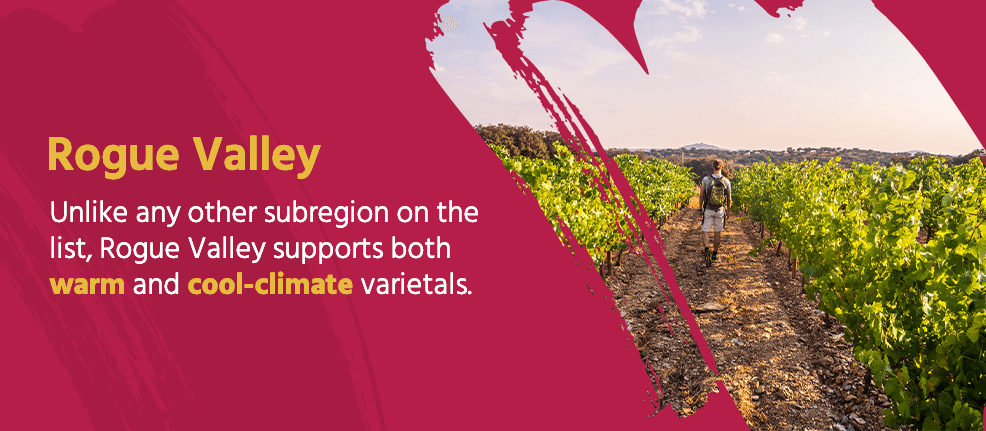
Consider Rogue Valley the melting pot of Oregonian wines. Unlike any other subregion on the list, Rogue Valley supports both warm and cool-climate varietals. Not only that, but it maintains some of the most diverse and varied soil types in the entire state, each tucked into progressively higher elevations across Rogue Valley’s three major zones. Each valley also holds a unique micro-climate, the cherry on top of a truly exceptional Oregon wine region.
Vineyards in the western half of Rogue Valley are the lowest and coolest. Perched at the foothills of the Siskiyou Mountains, eastern Rogue Valley’s loamy soil and ocean-initiated rainfalls are ideal for thin-skinned, compact grapes like pinot noir and pinot gris. Travel east, and you enter new wine territory: The denser clay-like soil mixes with warmer, dryer air and higher overall topography levels much better for warm-climate grapes like cabernet sauvignon and sauvignon blanc. Some east Rogue Valley wineries even grow varietals at our just over 2,000 feet above sea level, making them among the highest-elevated wineries in the state.
Just about any grape varietal can grow somewhere in Rogue Valley. The 70-mile-wide, 60-mile-long subregion is remarkable not only among the best wine regions in Oregon, but in the entire United States.
10. Snake River Valley
If Rogue Valley is the melting pot of Oregonian wines, consider Snake River Valley the Goldilocks of Oregon’s warm-climate varietals.
The Snake River Valley is the only major subregion AVA in Southeast Oregon. With its distinct location comes an equally unusual climate, soil and elevation levels, producing signature wines unlike any other in the state.
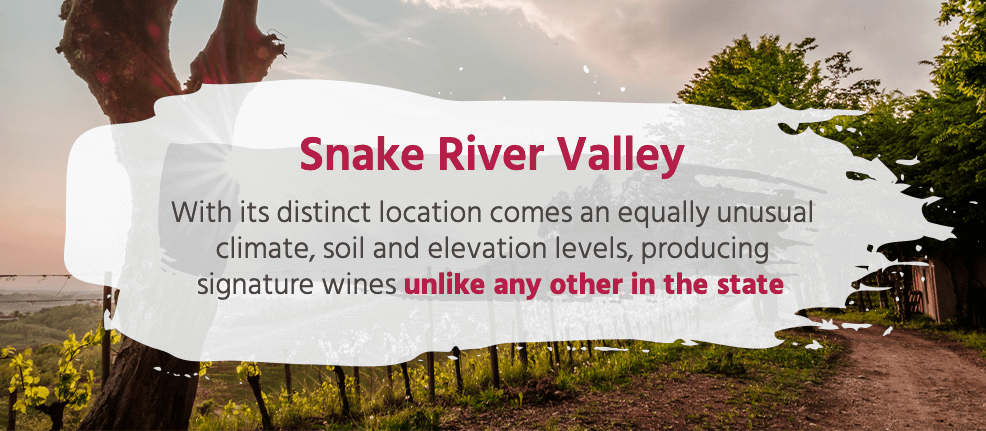
Most of the Snake River Valley sits between 2,500 and 3,000 feet above sea level. Many experts point to this elevation as a geographic gold standard for vineyard growth, away from the breezy, brined gusts of the Pacific Ocean. Seasonal temperature shifts drive growth conditions here. The Snake River Valley experiences four separate seasons, including winter temperatures dipping low enough for vines to go dormant. This rest rejuvenates nutrients in the soil beds, and also kills off many infections bugs and vine diseases.
When the warmer months roll around, grapes get treated to sweetening sunbaths during the day yet mild temperatures at night. The hot-cold dynamic balances the sugary fruit and tart acidic notes of Snake River Valley wines so prized for their complexity.
This four-season cycle is part of the reason sustainable and biodynamic wine production is not only reasonable, but standard practice in the Snake River Valley. With over 8,000 square miles to play with, its producers won’t be running out of room to do so anytime soon.
11. Umpqua Valley
Umpqua Valley might be the reason Oregon is on the world’s wine radar.
It was here that Richard Sommer, one of the founding figures of Oregonian wine, first planted pinot noir and riesling grapes in 1961. Many in his viticulture circle thought him crazy, saying no vineyards would take in Oregon. Boy, were they wrong.
Fast-forward to today, and Umpqua has blossomed into three distinct wine-growing zones. The northern zone, near Elkton, produces beautiful pinot noirs within its rainy, sandy, cool-climate setting. The southern zone mirrors the topography and dry climate of its neighboring Rogue Valley and grows syrahs, cabernet sauvignons and merlots with aplomb. Finally, Umpqua’s central zone does it all, offering both warm and cool varietals delicately balancing sweetness and acidity.
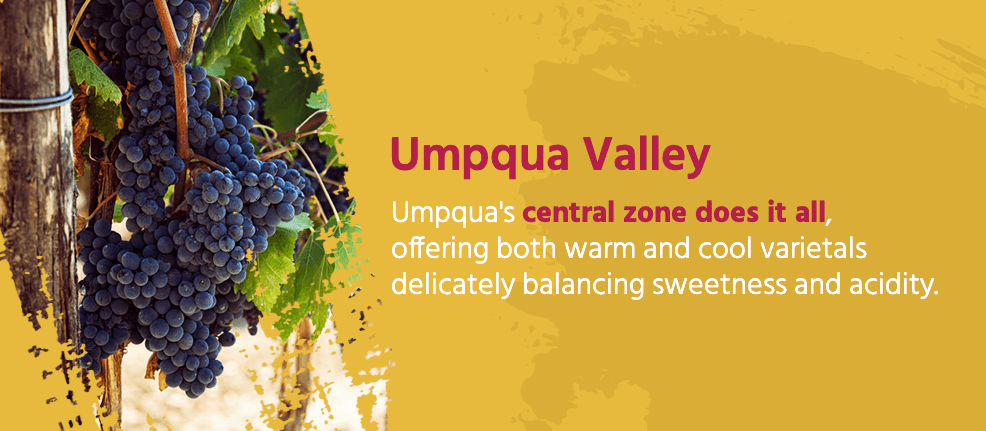
All three of its valleys sit nestled between the Coastal Range to its west and the Cascades to its east. When seeking all Oregon’s regions have to offer, look no further than Umpqua Valley wines.
12. Yamhill-Carlton
Tucked into northwest Oregon is the quaint, cozy Yamhill-Carlton wine region, which unquestionably makes some of Oregon’s best pinot noirs.
This task is no small undertaking, seeing as pinot noir is the signature varietal of the state. Yamhill-Carlton’s high elevation nestled into three separate mountain ranges means it receives just the right mix of sun, rain, frost and soil drainage to satisfy the notoriously fussy pinot noir. The subregion’s sandstone and siltstone soil makeup don’t hurt, either, lending a unique, soft minerality to its varietals.
Other cool-climate grapes like riesling and chardonnay do well here, though they must compete with the notoriety of Yamhill-Carlton’s pinot noirs for the same celebrity appeal. We say play it safe and try them all.
Explore the Best of Oregon’s Wines
Marketview Liquor has a wide selection of Oregon wines sourced straight from the state’s top regions and winemakers.
Browse our Oregon wine catalog to pick out old and new favorites. You can place your order online and we’ll ship it right to your doorstep.

